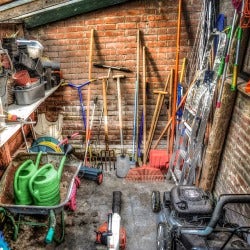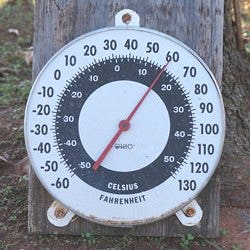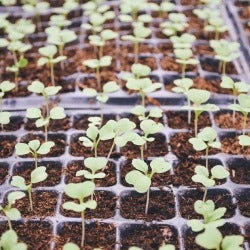
Autumn is here (at least for some of us) and that means our gardens are relaxing after the heat of summer.
Some gardens are still in full bloom. In mild climates, plants will enjoy a second burst of growthSome gardens are already getting ready for their winter snooze... in cool climates, plants are maybe losing their leaves in a colourful show, especially if there are morning frosts. You might already have had an early snowfall!
Some garden jobs are ready to do now, some may need to wait until later in the season - it all depends on the local climate of your own garden.
If you spend only ten minutes a day in your garden, you can make a real difference with little effort.
Lucky Dip Garden Jobs
If you have a big garden, a big list of tasks to tackle, or little enthusiasm for garden tidying, why not try making into a kind of game?
- Write each of the 50 jobs below onto a separate piece of paper, pop them into a bag, and each day pull out a task to do. It's a lucky dip!
- Set a timer and see how much you can get done in ten minutes. We bet once you start, you'll want to carry on a little longer.
- Challenge a friend to see who can get the most jobs ticked off their list before the end of the month
Grab your sharp snips, your garden gloves, a bucket or binbag, and a cuppa (or something stronger, if that helps get the job done...) - and pick a list below!
5 Organising and Planning Jobs

- Autumn is ideal planting time - so if there's any area of your garden that needs a remodel, this is a perfect time to make plans and designs
- Test the pH of your soil to ensure it's right for the plants you are growing - and want to grow in future
- Sort your seed packets - organise them by time of sowing, flower colour, place in the garden - whatever makes it easier for you.
Autumn can be as busy a seed-sowing season as spring! - Prop up container plants on pot feet, on slatted shelves - or at a pinch, two parallel lengths of 2x4 planks.
Autumn rains can drown a potted plant if the excess water can't drain away. - Group indoor plants together to make regular watering and misting easier, once you put the heat on for winter
10 Cleaning and Tidying Jobs

- Remove the supports from tall perennial plants, and cut the flowering stems back.
Chop them early in autumn, and in mild climates you may get a second burst of flowers - Pull up any annuals that have finished flowering, and add them to the compost heap
- Harvest the last of the summer produce from your annual kitchen garden plants - tomatoes, zucchini, cucumbers - and compost the old stalks
- Sweep up fallen leaves and add them to your compost heap
- Lift bulbs of tender summer bulb flowers like lilies and gladioli ready for replanting in spring after frosts. Dust off the soil and store them somewhere dry.If your garden is frost-free, you can tick off the above job, and leave the bulbs in place!
- Empty out hanging baskets of spent flowering annuals and give them a thorough clean.
- If you have a greenhouse to overwinter tender plants, now's the time to scrub it clean. Stop those bugs in their tracks!
- Clean your garden tools, and oil any wooden handles to keep them in good condition for years to come. Sharpen your secateurs, snips, and saws, and clean the blades with disinfectant
- Sweep out the shed, scrub and clean any benches or shelves you use for propagation and storage
- Wash and sort your empty plant pots ready for sowing seed and repotting plants

10 Pruning and Shaping Jobs

- Trim a lawn edge - even if you've no time to mow the whole lawn, a haircut can make all the difference
- Give a green hedge like box or Min a Min a light once-over clip to neaten and tip-prune it, which will help keep it bushy and green all over
- Divide a large spreading perennial to rejuvenate it. Dig it up, tease it apart into separate plants with roots and shoots (or be brave and chop the rootball vertically) and replant the new parts.
- Cut back a fast-growing climber that's got too big for its support. (Make sure it flowers on new green stems and not old woody ones)
- If you've been pruning and tidying, stack up logs, branches, and reedy hollow stems to create a bug hotel. Add in pine cones, bricks, and offcuts of wood too.
- Prune a summer-fruiting citrus once you have harvested the fruit. Water it with seaweed solution to help it recover.
- Cut back the old fruiting canes of summer fruiting berries to the ground. Leave newer canes in place to reduce the stress on the plant
- Snip off dead flowers from summer-flowering annuals, and perennials like lavender and salvia that have bloomed. This makes a garden bed instantly tidier without too much effort.
- Prune your summer-flowering woody shrubs like buddleia, pomegranate, and gardenia after they finish flowering.
Unless you get harsh winters, in which case you can leave it until spring. - Leave any flower stems that have turned into seedheads (like poppy, crepe myrtle, sunflower, echinacea) for hungry birds to snack on over winter - and you to enjoy for a little longer

10 Feeding and Caring Jobs

- Keep feeding and watering plants while the weather is warm; your garden will be growing
- Water and feed your azalea - many will be in the middle of their second flowering season, and will appreciate an energy boost
Targeted azalea food will give it the nutrients it needs - and it will work for any camellia or gardenia too - If you've had a summer drought, give a woody shrub a good long watering to help it absorb soil nutrients and encourage it to grow deep roots
- Improve the drainage on an area of compacted lawn by stabbing it with a garden fork (aerobic but effective) or walking over it in golf cleats (the cruisy way)
- Add seaweed solution to your watering can - it helps plants stay healthy to fight back against pests and diseases
- Give your glossy houseplant leaves a gentle wipe with a damp cloth, to remove the dust of summer and help them breathe
- Bring tender plants indoors or under shelter, ready for the winter
- Watch out for slugs and snails in wet weather - relocate them from your prized plants to unloved corners of the garden where birds can eat them
- Keep an eye on the weather forecast - autumn can mean summer-temperature heat. Protect your vulnerable plants by popping open an umbrella to cool them down in the shade. Make sure to water your tubestock regularly too.
- Keep an eye on any new plantings if the forecast is chilly. If you get cold winters, remember to protect your tubestock against frost and windchill, keeping them warm, as young plants will not be as weather resistant as mature established plants.

15 Planting and Sowing Jobs

- Plant out groundcovers now - they'll grow roots while the soil in warm, and in spring they'll grow more leaves to keep the roots of larger shrubs cool
- It's a perfect time to plant a new hedge - and with tubestock plants, that's a light and easy job with no hard digging!
- Autumn is also ideal tree-planting time - take care when siting new trees to give them enough room up and out, to grow to maturity
- Get groundcover plants in the soil and establishing now - ready to create a cooling living mulch come summer
- If you need to relocate any plants that are in the wrong place, or would look better in a different spot - now's your chance. You can always dig them up and put them into a large pot over winter while you remodel their new location.
- Plant up a pot of spring-flowering bulbs like daffodils, ranunculus, and freesia - spring-flowering bulbs need six months of growing before they flower, on average, and some like tulips need a spell of cold to trigger buds
- Plant spring bulbs under mature deciduous trees - bulbs are fantastic for poor dry soils, and by the time the tree leaves emerge overhead in spring, shading out the sunlight, the bulbs will have done most of their growing
- Plant up hanging baskets with hardy perennials or indoor plants and trailing succulents for winter colour
- Time to enjoy the garden is limited in winter when days are shorter. Get ready for this by planting a pair of pots for either side of your front door, to welcome you home.
- Sow seeds of flowering annuals for fast cheap colour - you could have blooms in 8 weeks
- Sow seeds of cold-hardy veggies like the cabbage family and onions
- It's time to plant up garlic corms to give you fresh juicy bulbs later in the year
- Sow seeds of peas and beans and tomatoes in pots indoors, ready to plant out when the weather warms up. If you don't get frosts, you can sow tomatoes year-round.
- Sow seed of salad leaves and herbs indoors for harvesting throughout winter. In frost-free climates you can plant these outside too



























